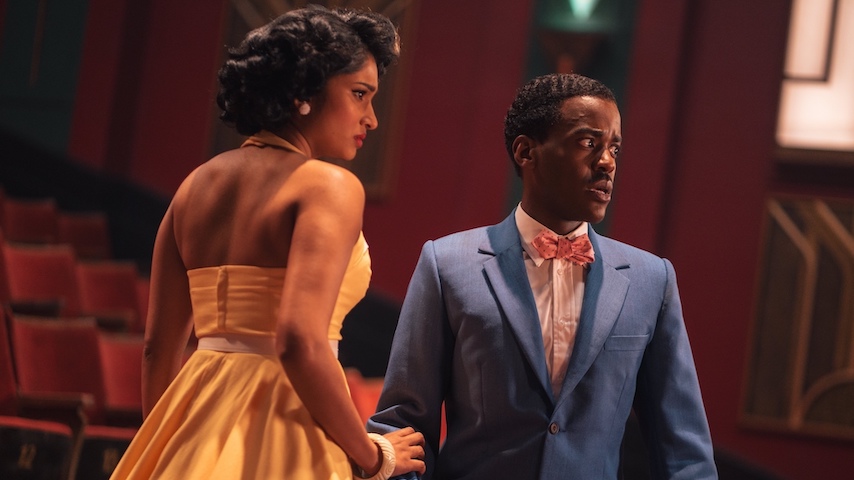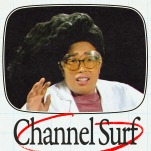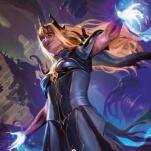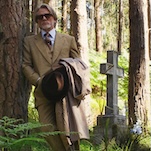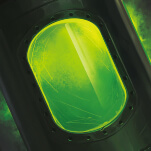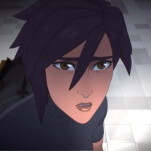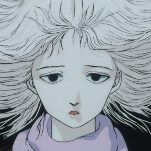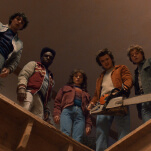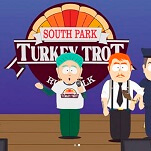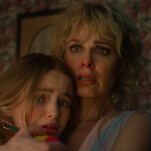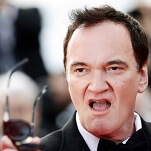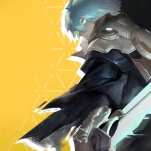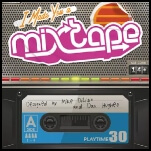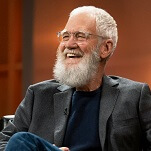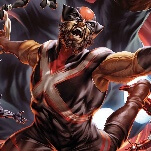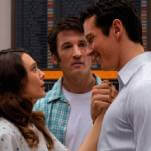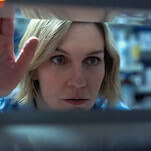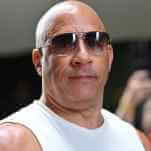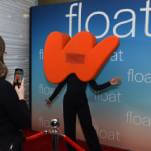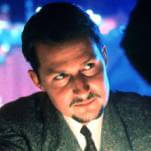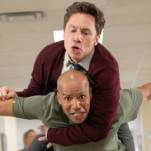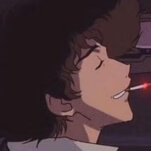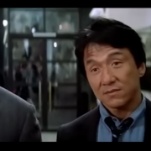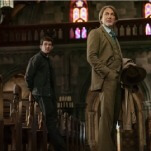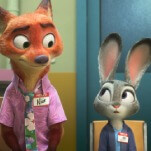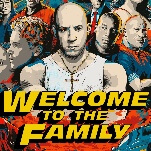Ask me to describe Ncuti Gatwa’s episodes as the lead of Doctor Who in one word, and I’d go with “ambitious.” So far, the series’ time on Disney+ has been characterized by bold stories where a lot is being attempted, even if not all of it works. The highly anticipated second episode of season two, “Lux”, epitomizes this era of the show. From a technical standpoint, I’m not sure Doctor Who has ever looked this good. The episode—which combines intricate, rich animation with live-action adventure, Who Framed Roger Rabbit-style—is a technicolor wonder, with stunning period production design and costumes to boot.
When it comes to the plot, things are less consistent, with the episode veering off sharply into unexpected directions. “Lux” kicks off in Miami in 1952. Over at a movie theater, an audience of children, parents and aggressively-making-out young lovers are watching a cartoon about Mr. Ring-A-Ding, a blue-skinned, pig-nosed little character voiced by Alan Cumming. With his sing-song voice and syncopated movements reminiscent of Steamboat Willie, Mr. Ring-A-Ding is loved for his repeated musical numbers and catchphrase: “Don’t make me laugh!” And it turns out that last one is more of a threat than anyone could have imagined. What happens if you get on the wrong side of Mr. Ring-A-Ding is realized one night when, powered by the moonlight, the character crawls out of the auditorium screen and the audience members scream in terror—then vanish.
With the TARDIS refusing to take Belinda back to May 24, 2025, the Doctor and his hesitant new companion make a pit stop in Miami. Belinda’s reluctance is put on pause when she’s given the option to wear a puffy 1950s dress and put her hair bouffant. “Belinda Chandra, this is the fun bit, honey: the clothes,” the Doctor says to his companion with a grin, grooving as he emerges in a sleek blue suit.
It’s the early morning when they arrive, which, the Doctor notes while surveying his own skin, “might be wise.” In an age when Doctor Who feels determined to tone down its political messaging, this episode is firm in making clear the realities of segregation. Belinda is understandably outraged when she learns that many of the spaces have a “no Blacks” policy that she would be considered under, but after the heavy handedness of last week’s “planet of the incels” comment, it’s good to see that these subjects can be directly addressed without all linguistic subtlety going out of the window in the process.
Of course, what is meant to be a short visit is extended when the Doctor notices the chained-up theater covered in flowers. It’s catnip for the Time Lord, and Belinda makes the joke about the “spooky old cinema” before we can. “You’re…Scooby-Doo!” she teases him. The knowledge that Reginald Pye (Linus Roache), who changes the film reels, remains inside and still plays the movies every night leaves the Doctor so delighted his head threatens to swing off his neck. “There is literally an old caretaker in a haunted cinema,” he tells Belinda, the Fred to his self-appointed Velma. What are they supposed to do, not go inside?
Inside, the pair come face to face with Mr. Ring-A-Ding. After hearing his echoing tap dancing, the animated man bursts out from behind the curtain with a showman’s “ta-dah!” None of the craftsmanship here has been rushed. Mr. Ring-A-Ding’s shadow is perfect, the Doctor’s eyeline always fixating on the exact right place when he crouches down to speak to this two-foot character.
Separated from the first scene, Mr. Ring-A-Ding seems harmless enough (if pretty annoying with his repeated singing and the same message not to make him laugh). Each time, those words sound more like a warning, and Mr. Ring-A-Ding’s eyebrows arch more fiercely. The Doctor begins to get it, asking, “Is there a reason we shouldn’t be making you laugh?” and the cartoon replies with a cackle that sounds an awful lot like Neil Patrick Harris’s Toymaker from “The Giggle”. Mr. Ring-A-Ding isn’t just a friendly cartoon gone bad but another member of the Pantheon Of Discord, featuring the Toymaker, Maestro and Sutekh. He is Lux, the god of light.
This fearsome god has been waiting in the movie theater, gaining power from the films Mr. Pye plays him; in exchange, Mr. Pye is able to dance, tragically, with his late wife again. Should he stop playing them, the highly flammable film stock would burn, taking her living memory with it. Mr. Ring-A-Ding’s motivations are unclear (“I’m a two-dimensional character; you can’t expect backstory,” he retorts to the Doctor, with a quippy line that leaves questions frustratingly unanswered.) What we do know is that the 15 missing people from that fateful screening have been trapped on film, and now it’s time for the Doctor and Belinda to be given the 2D treatment.
The cameras are turned back on our heroes, and, in another visually slick moment, they are rendered into flat, block-color cartoons. Their style is less classic Disney than Mr. Ring-A-Ding, prompting a sharp observational line from Belinda about the disproportionate size of her animated waist. But behind the cartoon, she’s panicking; and as she expresses her fears that the Doctor will never get home, the pair acquire depth and become more three-dimensional, cycling forward in animation styles with the introduction of shadows and texture. Eventually, they’re back to their normal selves but still stuck in the film. That is, until the Doctor looks down the barrel of the camera and walks forward towards the edge of the screen, tapping on a layer of glass between them and the viewer.
To make things even more meta, the pair then step out of the screen and into the living room of three Doctor Who fans (not the character, the show). Lizzie (Bronté Barbé), Hassan (Samir Arrian), and Robyn (Steph Lacey) are dressed in merch referencing previous Doctors. When Gatwa’s Doctor asks them what their favorite adventure of his is, they all say “Blink,” the 2007 David Tennant episode that first introduced the Weeping Angels, much to his chagrin.
The segment is clearly a tongue-in-cheek parody of fan culture, with Robyn saying that she predicted this would all happen because it leaked online. It’s a fairly fun, if slightly smug, piece of writing. But watching, I wasn’t focusing on this scene within the episode but rather what it means for Doctor Who as a whole. There have been Easter-egg references to the show within canon Doctor Who stories over the years, but they’ve been fleeting. It’s the blatantness that’s shocking here. What does it mean if Doctor Who exists in the world of Doctor Who? A whole new direction for the show, albeit one with a hell of a lot of plot holes? Equally, it could mean absolutely nothing—a throwaway scene by Russell T Davies that’s never mentioned again.
But I must go back to this subplot’s significance within the episode, where things get even more confused as the trio of fans admit that they don’t actually exist. “We’re the sort of characters who don’t have surnames” they say. But while they might have been created as part of Mr. Ring-A-Ding’s trap, their hours spent watching Doctor Who have given them the knowledge to outsmart the creature. Standing in front of the Doctor Who logo on the screen, they wave the Doctor off—and themselves out of existence—with these words: “We love you so much.” It’s a sweet message about the power of fandom but at what cost? I guess we’ll find out in the future. Or not.
Having finally broken out of the film with Belinda, the Doctor is captured by Mr. Ring-A-Ding, who uses reels of film brought to life to hoist the Doctor into the air, as Maestro did to Ruby (Millie Gibson) with music in “The Devil’s Chord.” The projector’s light shines through the Doctor, imbuing Mr. Ring-A-Ding with his Time Lord strength as he begins to grow and then develop in depth. Initially, shadows appear as he becomes a blue 3D model, but he soon becomes grotesque. With his veiny, bloodshot eyes, yellowing teeth, and bulging features, he is a children’s cartoon brought to life gone horribly, horribly wrong.
On the Doctor’s orders, Belinda runs to the film store with the aim—just like super-fan Robyn predicted—to send the whole thing up in flames. The building blasts apart after Mr. Pye steps in as a last-minute hero and supplies the match for the blaze; but while Mr. Ring-A-Ding reverts to 2D animation (a much-needed sight for sore eyes) and continues to grow out in the uninhibited light, it proves too much for him. Awestruck at the wonder of the light, he floats off, wide-eyed and misty as he repeats: “The light of creation, I am everything and I am nothing.”
It’s a strange ending, one that leaves many more questions unanswered. (Which gods will pop up next?) For now, all that’s left is for the missing people to step out of the movie theater and be reunited with their families, and, of course, the mysterious Mrs. Flood to pop up at the eleventh hour with a cryptic warning that the Doctor’s run will be “limited.” “Show ends, May 24th,” she says, flashing that menacing smile once more.
Stray observations
- • Doctor Who has featured post-credits scenes in the past, but this one, which sees the three fans critiquing the episode then screaming in delight at the realization that they haven’t died, feels distinctly Marvel-esque. Whether it’ll turn out to mean anything or not, I simply don’t know.
- • A film starring Rock Hudson is playing at the movie theater when the TARDIS lands, prompting a passing comment from Belinda about studying him in her HIV course at nursing school. It’s a sweet, simple tribute and a brief nod to Davies’ work on It’s A Sin.
- • I can’t say enough good things about the animation (and writing for animation) in “Lux.” But Mr. Ring-A-Ding’s sob story being orchestrated by mournful strings and Belinda confirming that this sound is, in fact, diegetic with “You’ve got your own soundtrack!?” really made me chuckle.
